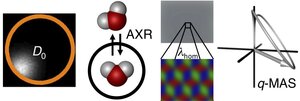Daniel Topgaard
The structure of the brain changes during learning processes such as language acquisition. The structural changes take place on a range of length scales: from the formation of new connections between individual neurons to the growth of entire brain regions. Magnetic resonance imaging (MRI) gives information on brain structure through measurements that can be completely non-invasive, a fact that is of particular importance for learning studies. The fundamental limits to the spatial resolution in MRI unfortunately prohibit the acquisition of images where single nerve cells can be resolved. Still, one can get microstructural information averaged over millimeter-size volume elements. This presentation gives an overview of our new diffusion MRI methods utilizing the micrometer-scale translational motion of water to map the size, shape, density, orientation, and membrane permeability of the cells. The non-invasive character and the information made available by the new methods give them great potential for answering the question of what happens to the brain on the microstructural level during the acquisition of new knowledge.

About the speaker
Topgaard is currently developing new diffusion NMR and MRI methods for non-invasively studying molecular motion on the micrometer length scale and millisecond time scale. By following the self-diffusion of molecules in a cellular system, information about structure and dynamics on the cellular scale can be obtained. Topgaard and his group design new diffusion NMR/MRI protocols for estimating parameters such as the diffusion coefficient of the intracellular medium, cell membrane permeability, microscopic anisotropy, and the length scale at which an inhomogeneous medium starts to appear homogeneous.
homepage
